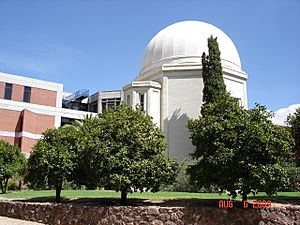Steward Observatory facts for kids
Quick facts for kids Steward Observatory |
|||||||||||||
|---|---|---|---|---|---|---|---|---|---|---|---|---|---|

The observatory on the campus of the University of Arizona in Tucson
|
|||||||||||||
| Organization | University of Arizona | ||||||||||||
| Location | Tucson, Arizona | ||||||||||||
|
Coordinates
|
32°14′00″N 110°56′56″W / 32.2333°N 110.9490°W
|
||||||||||||
| Altitude | 792 meters (2,598 ft) | ||||||||||||
| Established | 1916 | ||||||||||||
|
|||||||||||||
Steward Observatory is a major part of the Astronomy Department at the University of Arizona (UA). Its main offices are in Tucson, Arizona, in the United States. The observatory was started in 1916. Its first telescope and building were officially opened on April 23, 1923.
Today, Steward Observatory runs or partners with telescopes in many places. These include five mountain tops in Arizona, and one location each in New Mexico, Hawaii, and Chile. It has also built special tools for three different space telescopes and many telescopes on Earth. Steward Observatory is also one of the few places in the world that can make the very large primary mirrors used in modern telescopes.
Contents
How Steward Observatory Started
Steward Observatory exists thanks to Andrew Ellicott Douglass, an American astronomer. In 1906, Douglass became a professor at the University of Arizona in Tucson, Arizona. Soon after arriving, he began studying space using a telescope borrowed from the Harvard College Observatory. He quickly started looking for money to build a large research telescope in Tucson.
For 10 years, Douglass tried to get money from the University and the Arizona government. But all his attempts failed. During this time, he worked as the head of the Physics and Astronomy Department and even as the University's interim president.
A Secret Gift for a Telescope
Then, on October 18, 1916, something amazing happened. The University President, Rufus B. von KleinSmid, announced that a secret donor had given $60,000. This money was to buy "a telescope of huge size." Later, the donor was revealed to be Mrs. Lavinia Steward from Oracle, Arizona. She was a wealthy widow who loved astronomy and wanted to honor her late husband, Mr. Henry Steward.
Douglass planned to use Mrs. Steward's gift to build a 36-inch wide reflecting telescope. The Warner & Swasey Company in Cleveland, Ohio was hired to build it.
Challenges in Building the Telescope
Building the telescope faced delays because of World War I. Warner & Swasey had to focus on war projects first. Another problem was that making large telescope mirrors was mostly done in Europe. The war made it impossible to work with European companies.
So, Douglass had to find an American glass company willing to learn how to make these big mirrors. After a few tries, the Spencer Lens Co. in Buffalo, New York successfully made the 36-inch mirror for the Steward Telescope.
The telescope was finally put into the observatory building in July 1922. Steward Observatory was officially opened on April 23, 1923.
Where Steward Observatory Works
Steward Observatory manages three different places where telescopes are used in southern Arizona. These are the Mount Graham International Observatory (MGIO), Mount Lemmon Observatory, and Catalina Station on Mount Bigelow.
It also helps run telescopes at two other important observatories. These are Kitt Peak National Observatory (KPNO) and Fred Lawrence Whipple Observatory on Mount Hopkins. Steward is also a partner in the Sloan Digital Sky Survey-III, which is in New Mexico at Apache Point Observatory.
There is also a student observatory on Tumamoc Hill, about 5 kilometers (3 miles) west of the main campus. The original observatory building in Tucson is now used for public events and teaching college students.
Radio Astronomy and International Projects
The Arizona Radio Observatory is part of Steward Observatory. It operates one radio telescope at KPNO and another at MGIO.
Steward Observatory also takes part in three projects around the world. It is a full member of the twin Magellan Telescopes at Las Campanas Observatory in northern Chile. It is also involved in two future projects planned for the same area: the Large Synoptic Survey Telescope and the Giant Magellan Telescope. These are next-generation, very large telescopes. The Richard F. Caris Mirror Laboratory is making the mirrors for both of these new telescopes. It also made the two Magellan mirrors.
What Research Groups Do
Steward Observatory has several groups that do amazing research.
Making Giant Mirrors
The Richard F. Caris Mirror Laboratory is located under the east side of Arizona Stadium. This lab has created new ways to make large mirrors. They use methods like spin-casting lightweight honeycomb mirrors in a rotating furnace. They also use a special polishing technique called stressed-lap polishing.
The Mirror Laboratory finished the second mirror for the Large Binocular Telescope in September 2005. The Mirror Lab also made the 8.4-meter wide primary mirror for the Large Synoptic Survey Telescope. They have also started working on two of the seven mirrors for the Giant Magellan Telescope.
Building Space Telescope Instruments
The Infrared Detector Laboratory builds special tools for telescopes. They built the Near Infrared Camera and Multi-Object Spectrometer (NICMOS) for the Hubble Space Telescope. They also made the Multiband Imaging Photometer (MIPS) for the Spitzer Space Telescope.
For the James Webb Space Telescope, Steward built the Near-Infrared Camera (NIRCam). They also helped build the Mid-IR Instrument (MIRI). Both of these tools have been given to NASA.
Other Research Areas
Other groups at Steward Observatory include:
- The Center for Astronomical Adaptive Optics (CAAO)
- The Imaging Technology Laboratory (ITL)
- The Steward Observatory Radio Astronomy Laboratory (SORAL)
- The Earths in Other Solar Systems (EOS) group, which looks for planets outside our solar system.
- The Astrochemistry/Spectroscopy Laboratory, which studies the chemicals in space.
Images for kids
-
Kuiper telescope image of Pluto and its moon Charon
-
The 36-inch telescope in 1922 (it was moved to Kitt Peak in 1963)
See also
 In Spanish: Observatorio Steward para niños
In Spanish: Observatorio Steward para niños



